An online project under the direction of the CAPE ANN MUSEUM
inv. 9
A Smart Blow
Rough Sea, Schooners
c. 1856 Oil on canvas 11 3/4 x 19 in. (29.8 x 48.3 cm) Frame: H. 21 1/4 x 35.6 in. (54 cm) 14 No inscription found
|
Supplementary Images
Explore catalog entries by keywords view all keywords »
Historical Materials
Below is historical information related to the Lane work above. To see complete information on a subject on the Historical Materials page, click on the subject name (in bold and underlined).
Newspaper
Scene on George's Bank, p. 2, col. 1
American Antiquarian Society
"Scene on George's Bank. Yesterday afternoon we had the pleasure of seeing an oil painting executed by F.H. Lane, Esq., representing two vessels on Georges. One of them is at anchor, the sea making a complete breach over her, forward, while the rollers pass along midships seemingly lifting the vessel almost out of the water. Notwithstanding the apparent roughness of the sea, the crew are [sic] busily engaged hauling in codfish. The other vessel is under sail, flying over the billows like a thing of life, while the angry waves seem as though they would swallow her up. It is a wild looking scene, and said to be perfectly correct by those who have experienced themselves to the hardships and dangers attending George's fishing. The picture is now in the possession of Mr. John Trask."
Filed under: Georges Bank, Mass. » // Newspaper / Journal Articles » // Trask, John »
1873 Gloucester City Directory (1)
"The design is very pretty and appropriate . . .In the centre of the seal is a representation of a fishing schooner anchored on the banks, copied from a picture painted by that talented artist, the late Mr. Fitz H. Lane." (2)
References:
1. Gloucester City Directory. (Gloucester, MA: Sampson, Davenport, & Co., 1873), front page.
2. "The Town Seal": designed by Capt. Addison Center," Cape Ann Weekly Advertiser, February 9, 1872.
Filed under: Center, Addison » // Fishing » // Gloucester, Mass. Town Seal » // Publications »
Gravure plate printing on pulp paper in G. Brown Goode The Fisheries and Fishery Industries of the United States (Washington, DC: Government Printing Office)
7 1/2 x 5 7/8 in.
Cape Ann Museum Library & Archives, Gloucester, Mass.
See pl. 30.
Derived with modifications from Lane's painting, A Smart Blow, c.1856 (inv. 9), the image depicts fishing in heavy weather on Georges Bank. While Lane's version was intended to depict this fishery in the 1840s, Collins' version shows a dory on the stern davits instead of a yawl boat—a practice that became common after the Civil War.
– Erik Ronnberg
Schooners in Lane’s time were, with few exceptions, two-masted vessels carrying a fore-and-aft rig having one or two jibs, a fore staysail, gaff-rigged fore- and main sails, and often fore- and main topsails. One variant was the topsail schooner, which set a square topsail on the fore topmast. The hulls of both types were basically similar, their rigs having been chosen for sailing close to the wind. This was an advantage in the coastal trade, where entering confined ports required sailing into the wind and frequent tacking. The square topsail proved useful on longer coastwise voyages, the topsail providing a steadier motion in offshore swells, reducing wear and tear on canvas from the slatting of the fore-and-aft sails. (1)
Schooners of the types portrayed by Lane varied in size from 70 to 100 feet on deck. Their weight was never determined, and the term “tonnage” was a figure derived from a formula which assigned an approximation of hull volume for purposes of imposing duties (port taxes) oncargoes and other official levies. (2)
Crews of smaller schooners numbered three or four men. Larger schooners might carry four to six if a lengthy voyage was planned. The relative simplicity of the rig made sail handling much easier than on a square-rigged vessel. Schooner captains often owned shares in their vessels, but most schooners were majority-owned by land-based firms or by individuals who had the time and business connections to manage the tasks of acquiring and distributing the goods to be carried. (3)
Many schooners were informally “classified” by the nature of their work or the cargoes they carried, the terminology coined by their owners, agents, and crews—even sometimes by casual bystanders. In Lane’s lifetime, the following terms were commonly used for the schooner types he portrayed:
Fishing Schooners: While the port of Gloucester is synonymous with fishing and the schooner rig, Lane depicted only a few examples of fishing schooners in a Gloucester setting. Lane’s early years coincided with the preeminence of Gloucester’s foreign trade, which dominated the harbor while fishing was carried on from other Cape Ann communities under far less prosperous conditions than later. Only by the early 1850s was there a re-ascendency of the fishing industry in Gloucester Harbor, documented in a few of Lane’s paintings and lithographs. Depictions of fishing schooners at sea and at work are likewise few. Only A Smart Blow, c.1856 (inv. 9), showing cod fishing on Georges Bank (4), and At the Fishing Grounds, 1851 (inv. 276), showing mackerel jigging on Georges Bank, are known examples. (5)
– Erik Ronnberg
References:
1. Howard I. Chapelle, The History of American Sailing Ships (New York: W.W. Norton & Co., 1935), 258. While three-masted schooners were in use in Lane’s time, none have appeared in his surviving work; and Charles S. Morgan, “New England Coasting Schooners”, The American Neptune 23, no. 1 (DATE): 5–9, from an article which deals mostly with later and larger schooner types.
2. John Lyman, “Register Tonnage and its Measurement”, The American Neptune V, nos. 3–4 (DATE). American tonnage laws in force in Lane’s lifetime are discussed in no. 3, pp. 226–27 and no. 4, p. 322.
3. Ship Registers of the District of Gloucester, Massachusetts, 1789–1875 (Salem, MA: The Essex Institute, 1944). Vessels whose shipping or fishing voyages included visits to foreign ports were required to register with the Federal Customs agent at their home port. While the vessel’s trade or work was unrecorded, their owners and master were listed, in addition to registry dimensions and place where built. Records kept by the National Archives can be consulted for information on specific voyages and ports visited.
4. Howard I. Chapelle, The National Watercraft Collection (Washington, DC: Smithsonian Institution, 1960), 74–76.
5. Howard I. Chapelle, The American Fishing Schooners (New York: W.W. Norton & Co., 1973), 58–75, 76–101.
1852
Oil on canvas
28 x 48 1/2 in.
Cape Ann Museum, Gloucester, Mass., Deposited by the City of Gloucester, 1952. Given to the city by Mrs. Julian James in memory of her grandfather Sidney Mason, 1913 (DEP. 200)
Detail of fishing schooner.
Also filed under: Gloucester Harbor, Inner / Harbor Cove »
Stereograph card
Frank Rowell, Publisher
stereo image, "x " on card, "x"
Cape Ann Museum Library & Archive
View showing a sharpshooter fishing schooner, circa 1850. Note the stern davits for a yawl boat, which is being towed astern in this view.
Also filed under: Historic Photographs »
Model made for marine artist Thomas M. Hoyne
scale: 3/8" = 1'
Thomas M. Hoyne Collection, Mystic Seaport, Conn.
While this model was built to represent a typical Marblehead fishing schooner of the early nineteenth century, it has the basic characteristics of other banks fishing schooners of that region and period: a sharper bow below the waterline and a generally more sea-kindly hull form, a high quarter deck, and a yawl-boat on stern davits.
The simple schooner rig could be fitted with a fore topmast and square topsail for making winter trading voyages to the West Indies. The yawl boat was often put ashore and a "moses boat" shipped on the stern davits for bringing barrels of rum and molasses from a beach to the schooner.
– Erik Ronnberg
References:
Jeffrey Bolster, Black Jacks: African American Seafarers in the Age of Sail (Cambridge, MA: Harvard University Press, 1997).
Howard I. Chapelle, American Small Sailing Craft (New York: W.W. Norton & Co., 1951), 29–31.
Also filed under: Hand-lining » // Ship Models »
20 x 14 in.
Cape Ann Museum Library & Archive, Gloucester, Mass.
The image, as originally drafted, showed only spars and sail outlines with dimensions, and an approximate deck line. The hull is a complete overdrawing, in fine pencil lines with varied shading, all agreeing closely with Lane's drawing style and depiction of water. Fishing schooners very similar to this one can be seen in his painting /entry:240/.
– Erik Ronnberg
Newspaper
"Shipping Intelligence: Port of Gloucester"
"Fishermen . . . The T. [Tasso] was considerably injured by coming in contact with brig Deposite, at Salem . . ."
Also filed under: Newspaper / Journal Articles »
Newsprint
From bound volume owned by publisher Francis Procter
Collection of Fred and Stephanie Buck
"A Prize Race—We have heard it intimated that some of our fishermen intend trying the merits of their "crack" schooners this fall, after the fishing season is done. Why not! . . .Such a fleet under full press of sail, would be worth going many a mile to witness; then for the witchery of Lane's matchless pencil to fix the scene upon canvass. . ."
Also filed under: Fishing » // Newspaper / Journal Articles »
Also filed under: Cape Ann Advertiser Masthead »
Stereograph card
Procter Brothers, Publisher
Cape Ann Museum Library & Archive
"Gloucester Harbor from Rocky Neck, Looking Southwest. This gives a portion of the Harbor lying between Ten Pound Island and Eastern Point. At the time of taking this picture the wind was from the northeast, and a large fleet of fishing and other vessels were in the harbor. In the range of the picture about one hundred vessels were at anchor. In the small Cove in the foreground quite a number of dories are moored. Eastern Point appears on the left in the background."
Southeast Harbor was known for being a safe harbor.
Also filed under: Gloucester Harbor, Outer » // Historic Photographs » // Rocky Neck » // Small Craft – Wherries, and Dories »
Stereograph card
Cape Ann Museum Library & Archive
"Said schooner was captured about the first of September, 1871, by Capt. Torry, of the Dominion Cutter 'Sweepstakes,' for alleged violation of the Fishery Treaty. She was gallantly recaptured from the harbor of Guysboro, N.S., by Capt. Harvey Knowlton., Jr., (one of her owners,) assisted by six brave seamen, on Sunday night, Oct. 8th. The Dominion Government never asked for her return, and the United States Government very readily granted her a new set of papers."
Also filed under: Fishing » // Historic Photographs » // Waterfront, Gloucester »
Photograph
Cape Ann Museum Library & Archive
Also filed under: Gloucester Harbor, Inner / Harbor Cove » // Historic Photographs » // Waterfront, Gloucester »
Cape Ann Museum Library & Archive (2013.068)
Schooner fleet anchored in the inner harbor. Looking east from Rocky Neck, Duncan's Point wharves and Lane house (at far left), Sawyer School cupola on Friend Street.
Also filed under: Duncan's Point » // Gloucester Harbor, Inner / Harbor Cove » // Historic Photographs » // Waterfront, Gloucester »
See p. 254.
As Erik Ronnberg has noted, Lane's engraving follows closely the French publication, Jal's "Glossaire Nautique" of 1848.
Also filed under: Babson History of the Town of Gloucester »
Wood, cordage, acrylic paste, metal
~40 in. x 30 in.
Erik Ronnberg
Model shows mast of fishing vessel being unstepped.
Also filed under: Burnham Brothers Marine Railway » // Fishing »
Watercolor on paper
8 3/4 x 19 3/4 in.
Cape Ann Museum, Gloucester, Mass., Gift of Rev. and Mrs. A. A. Madsen, 1950
Accession # 1468
Fishing schooners in Gloucester's outer harbor, probably riding out bad weather.
Also filed under: Elwell, D. Jerome » // Gloucester Harbor, Outer »
Photograph
Cape Ann Museum Library & Archive
Ignatius Weber's windmill (now defunct) is shown.
Also filed under: Flake Yard » // Fort (The) and Fort Point » // Gloucester Harbor, Inner / Harbor Cove » // Historic Photographs » // Rogers's (George H.) wharves » // Waterfront, Gloucester » // Windmill »
Print from bound volume of Gloucester scenes sent to the Philadelphia Centennial Exhibition.
11 x 14 in.
Cape Ann Museum Library & Archives
Schooner "Grace L. Fears" at David A. Story Yard in Vincent's Cove.
Also filed under: Historic Photographs » // Shipbuilding / Repair » // Vincent's Cove »
The term “wherry”—variously spelled—has a long history with many hull types, some dating from the fifteenth century. (1) The version known to Lane appears to be a variant of the dory hull form and probably was developed by French and English fishermen in the Newfoundland fisheries before 1700. (2) From that time, the wherry and the dory co-evolved, their similarities the result of their construction, their differences the result of use. By the early nineteenth century, their forms reached their final states, if fragments of contemporary descriptions are any indication. (3)
By the time Lane was depicting wherries, the type (as used for fishing) resembled a larger, wider version of a dory. The extra width was due to greater bottom width (both types had flat bottoms), with a wider transom at the stern instead of the narrow, v-shaped “tombstone.” These features are easy to see in one of his drawings (see Three Men, One in a Wherry (inv. 225)) and a painting (see Sunrise through Mist, 1852 (inv. 98)), the latter depicted alongside a dory, clearly showing the differences.
No published descriptions of the uses of wherries on Cape Ann in Lane’s time have come to light, but an example in broadside view offers one use. In Becalmed Off Halfway Rock, 1860 (inv. 344), a pinky (in right foreground) has a dory and a wherry in tow, the latter loaded with a gill net for catching mackerel. (4) The greater size of the wherry is required for stowing the net, as well as setting it while the dory tows away one end to set it in way of the mackerel school.
In Lane’s time, wherries would have been used where bulky gear was called for in the coastal fisheries, i.e. gill nets, and fish traps such as pound nets, fyke nets, and lobster traps. Migrating fish schools (herring, mackerel) and shellfish were the target species.
The dory’s development was first dictated by its use in shore fishing, where small size and light weight made it easy to maneuver around rocks and shallows, and to haul ashore at the end of a day’s work. Its simple design made it easy and cheap to build. This is borne out by the standardized construction and sizes used by Simon Lowell’s boat shop at Salisbury Point, Massachusetts at the turn of the nineteenth century. Lowell called his boats “wherries,” but in Swampscott, Massachusetts, the fishermen, who used them called them “dories,” which may mark the beginning of the latter term’s wider use. (5)
The dories we see in Lane’s paintings are in virtually every way like the ones we know today. One of the best examples (see View from Kettle Cove, Manchester-by-the-Sea, 1847 (inv. 94)) even shows interior detail, including frames, leaving no doubt about its construction. Other good examples are found in Salem Harbor, 1853 (inv. 53), View of Gloucester Harbor, 1848 (inv. 97), and Sunrise through Mist, 1852 (inv. 98).
For inshore fishing, dories were used to catch mackerel and herring, either with hook and line or with small nets. Hooks and line were used for flat fish (flounder, dab, and fluke), rock cod, hake, and cunner. Eels were speared (see View from Kettle Cove, Manchester-by-the-Sea, 1847 (inv. 94)), clams were dug, and lobsters trapped. In Lane’s later years, the use of dories in trawling (setting long “trawl lines” with many baited hooks) was in its earliest. This method required six to ten dories carried on board a schooner to fish on the distant banks off New England and Canada. Early records of dory trawling in New England are fragmentary, giving the mid-1840s as the time of introduction. (6) The Gloucester-owned schooner "Anna" made a successful dory trawling trip to the Grand Banks in 1854, but no depiction of this vessel by Lane has been found or recorded. (5) Despite successful early efforts, dory trawling from Gloucester was slow to be accepted, and the fishery had very limited growth prior to 1860. (7)
– Erik Ronnberg
References:
1. M.H. Parry et al., Aak to Zumbra (Newport News, VA: The Mariners’ Museum, 2000), 634.
2. John Gardner, The Dory Book (Camden, ME: International Marine Publishing Company, 1978), 5–9.
3. Ibid., 25–29.
4. John Wilmerding, ed., Paintings by Fitz Hugh Lane (Washington, DC: National Gallery of Art, 1988), 89, 92. The “possibly discarded whaleboat” is definitely a wherry.
5. Gardner, 9, 10.
6. Wesley George Pierce, Goin’ Fishin’ (Salem, MA: Marine Research Society, 1934), 63–64.
7. Raymond McFarland, A History of New England Fisheries (Philadelphia: University of Pennsylvania, 1911), 279.
Stereograph card
Procter Brothers, Publisher
Cape Ann Museum Library & Archive
"Gloucester Harbor from Rocky Neck, Looking Southwest. This gives a portion of the Harbor lying between Ten Pound Island and Eastern Point. At the time of taking this picture the wind was from the northeast, and a large fleet of fishing and other vessels were in the harbor. In the range of the picture about one hundred vessels were at anchor. In the small Cove in the foreground quite a number of dories are moored. Eastern Point appears on the left in the background."
Southeast Harbor was known for being a safe harbor.
Also filed under: Gloucester Harbor, Outer » // Historic Photographs » // Rocky Neck » // Schooner (Fishing) »
Also filed under: Chebacco Boat / Dogbody / Pinky » // Ship Models »
Gloucester, MA
4 x 33 1/2 x 7 1/4 in (10.16 x 85.09 x 18.415 cm)
Peabody Essex Museum
Also filed under: Objects » // Ship Models »
Cod fishing with hand-lines (hand-lining) from the deck of a schooner was the predominant method used on offshore fishing grounds prior to the Civil War. Offshore grounds included the Grand Banks of Newfoundland, the banks off Nova Scotia, numerous small grounds in the Gulf of Maine, and Georges Bank.
Hand-lining from dories and wherries was the inshore version of this fishery, the boats being hauled ashore at the end of a day's work.Their fishing grounds ranged from the shoreline to Ipswich Bay, and a multitude of small grounds a mile or two offshore. Colonial fishermen found the inshore grounds off Cape Ann—particularly Ipswich Bay—extremely rich, so much so that these grounds were the prime sources of market fish in that period.
Early the nineteenth century, hand-lining gear had become surprisingly complex, consisting of two hooks with leaders (gangings), swivels, a bridle and spreader, and a 20-pound sinker and staff. This rig was attached to a hand-line which could be as long as 900 feet, depending on the depth and type of bottom being fished. Gear of this size and complexity was coiled and stowed in a tub, instead of being wound on a wood frame.
Inshore fishing gear was much simpler: a line on a wooden winder, a hook at the end, and a sinker hitched to the line at the desired distance from the hook.
– Erik Ronnberg
Steel engraving after drawing in G. Brown Goode, The Fisheries and Fishery Industries of the United States (Washington, DC: Government Printing Office)
8 1/2 x 11 in. (page size)
Cape Ann Museum Library & Archive, Gloucester, Mass.
See pl. 31.
Shows the two basic types of hand-line gear in use in mid-ninteenth century. At left is the Georges gear, developed for fishing on Georges Bank. At right is shoal water gear, as commonly used in the inshore fisheries using dories and other small craft. The spreader, or "sling-ding" was used on this type of gear with the advent of dory hand-lining on offshore grounds.
Also filed under: Hand-lining »
Steel engraving after drawing in G. Brown Goode, The Fisheries and Fishery Industries of the United States (Washington, DC: Government Printing Office, 1883)
8 1/2 x 11 in. (page size)
Cape Ann Museum Library & Archive, Gloucester, Mass.
See pl. 32.
Also filed under: Georges Bank, Mass. » // Hand-lining »
Cape Ann Museum Library & Archive
Also filed under: Drying Fish » // Flake Yard » // Historic Photographs »
Newsprint
Cape Ann Advertiser
Collection of Fred and Stephanie Buck
"VISIT TO LANE'S STUDIO.
We called at the studio of this artist a few days ago, and found several new paintings had been added to his collection since our last visit. The first that arrested our attention was a view of Good Harbor Beach. . . .
A scene outside Eastern Point, during a fresh sou'wester, is full of life, and faithfully portrayed on the canvass. . . .
A fancy sketch, representing a storm scene, is also on exhibition. . . .
The Artist has now on his easel a large picture 36x60, just commenced, which we should judge would be his master-piece. It will be on exhibition when finished, and we forbear a description of it at this time. Mr. Lane, as a marine painter, ranks first in the country, and we are pleased to chronicle his success in producing such life-like pictures."
Also filed under: Fishing » // Newspaper / Journal Articles » // Rockport, Mass. - Thacher Island Twin Lighthouses » // Studio Descriptions » // Thacher Island »
In G. Brown Goode, The Fisheries and Fishery Industries of the United States (Washington, DC: Government Printing Office)
A vessel having returned from the fishing grounds with a fare of split salted cod, is discharging it at a fish pier for re-salting and drying. The fish are tossed from deck to wharf with sharp two-pronged gaffs, and from there to a large scale for weighing. From there, they will be taken to another part of the wharf for washing and re-salting.
– Erik Ronnberg
Also filed under: Drying Fish » // Fishing » // Georges Bank, Mass. »
T. Moore's Lithography, Boston
12 1/2 x 9 1/2 in.
20 x 16 3/4 in (Framed)
Cape Ann Museum, Museum Purchase (2014.089.2)
Also filed under: Johnston, David Claypoole » // Moore's, T. - Lith. - Boston » // Sheet Music by other artists »
New York Public Library
Also filed under: Drying Fish »
Gravure plate printing on pulp paper in G. Brown Goode The Fisheries and Fishery Industries of the United States (Washington, DC: Government Printing Office)
7 1/2 x 5 7/8 in.
Cape Ann Museum Library & Archives, Gloucester, Mass.
See pl. 30.
Derived with modifications from Lane's painting, /entry:9/, the image depicts fishing in heavy weather on Georges Bank. While Lane's version was intended to depict this fishery in the 1840s, Collins' version shows a dory on the stern davits instead of a yawl boat—a practice that became common after the Civil War.
– Erik Ronnberg
Also filed under: Georges Bank, Mass. » // Goode, The Fisheries and Fishing Industries of the United States »
In G. Brown Goode The Fisheries and Fishery Industries of the United States (Washington, DC: Government Printing Office)
See pl. 35.
After landing and weighing, the cod are split and washed, a dory filled with water serving as the wash tub. Once thoroughly rinsed of the coarse first salting, the split cod are piled in the wharf shed where they will be re-salted, usually with a finer grade of salt, and stored in bins or large casks until ready for drying on the fish flakes.
– Erik Ronnberg
Also filed under: Drying Fish »
Until the early 1830s fishing on Georges Bank had been done on a small scale since colonial times. Its dangerous shoals and ferocious seas in storms discouraged any large-scale fishing attempts. Even then, anchoring to fish—particularly in winter—was at risk of danger in the event of heavy weather. Vessels at anchor during a blizzard faced not only mountainous waves, decks and rigging iced over, and piercing cold, but the risk of collision with another vessel whose anchor cable had parted and was helplessly drifting down on vessels in her lee. Such collisions were usually fatal to the vessels involved and their crews. The death toll in many years could be staggering, both for the fishery and the families of lost fishermen.
– Erik Ronnberg
Steel engraving after drawing in G. Brown Goode, The Fisheries and Fishery Industries of the United States (Washington, DC: Government Printing Office, 1883)
8 1/2 x 11 in. (page size)
Cape Ann Museum Library & Archive, Gloucester, Mass.
See pl. 32.
Also filed under: Cod / Cod Fishing » // Hand-lining »
Newspaper
Scene on George's Bank, p. 2, col. 1
American Antiquarian Society
"Scene on George's Bank. Yesterday afternoon we had the pleasure of seeing an oil painting executed by F.H. Lane, Esq., representing two vessels on Georges. One of them is at anchor, the sea making a complete breach over her, forward, while the rollers pass along midships seemingly lifting the vessel almost out of the water. Notwithstanding the apparent roughness of the sea, the crew are [sic] busily engaged hauling in codfish. The other vessel is under sail, flying over the billows like a thing of life, while the angry waves seem as though they would swallow her up. It is a wild looking scene, and said to be perfectly correct by those who have experienced themselves to the hardships and dangers attending George's fishing. The picture is now in the possession of Mr. John Trask."
Also filed under: Newspaper / Journal Articles » // Trask, John »
Newspaper
Gloucester Telegraph p. 2, col. 3
Boston Public Library
Accession # G587
"PICTURES. – Two of Lane's finest paintings are on exhibition at the Marine Insurance Reading Room. One is a most spirited representation of a gale on the sea coast. Huge rollers come rumbling towards the rocky foreground where the spray dashes high and the receding wave is thrown up sharp and wedgelike by the great crested breaker under which it is speedily overwhelmed. In the middle distance a bald headland receives the sun's rays which slant through the mist from an opening in the heavy clouds. A close reefed ship leaps proudly over the waves and safely weathers the dangerous point beyond.
The companion-piece is a bay scene in which the setting sun throws a flood of golden light over the placid water. Vessels of different kinds, with sails in light and shadow, enliven the picture. A homely old sloop getting underweigh well sets off the most prominent object - a handsome ship under full canvass, slowly gliding over the ground-swell with a light breeze afloat, while there is hardly enough below to make a cat's paw.
These pictures were painted for the spring exhibition of the National Academy at New York, whither they will go unless stopped by some appreciative purchaser.
In Lane's studio are several gems of art. - Wind against Tide on Georges, a stirring pure marine, and Recollections of Mount Desert, an exquisite bit of landscape, evince a versatility of pencil which he is not generally known to possess.
The demand for a View of Gloucester worth having (as that poor caricature of Tidd's is not) has induced Lane to supply another, which is the third and largest of his series. It is taken from Rocky Neck, like its predecessor. Of course all the modern improvements visible from that point of view are represented with the artist's usual accuracy of drawing. To the first 300 subscribers the print will be offered at the low price of $2.25 per copy. The original painting from which it is lithographed, and several other of his pictures, will be distributed by lot among those who choose to take their copies at $2.75 – a price which the print alone will command before the entire edition is exhausted."
Newspaper
"Scene on George's Bank- Yesterday afternoon we had the pleasure of seeing an oil painting, executed by F.H. Lane, Esq., representing two vessels on Georges. One of them is at anchor, the sea making a complete breach over her forward, while the rollers pass along midships, seemingly lifting the vessel almost out of water. Notwithstanding the apparent roughness of the sea, the crew are busily engaged hauling in codfish. The other vessel is under sail, flying over the billows like a thing of life, while the angry waves seem as if they would swallow her up. It is a wild looking scene, and said to be perfectly correct by those who have exposed themselves to the hardships and dangers attending Georges fishing. The picture is now in the possession of Mr. John Trask."
Also filed under: Newspaper / Journal Articles » // Trask, John »
U.S. Bureau of Fisheries, Mem. S-244
16 x 8 3/4 in. (original probably larger)
Private collection
Chart outlines principal fishing grounds, showing location of Georges Bank relative to southern New England.
Also filed under: Maps »
Whole chart 13 x 9 1/4 in.
Cape Ann Museum Library & Archive
This section of the chart shows the eastern end of Georges Bank and the winter codfishing ground. Note the locations of tide rips and shoals which posed particular hazards in easterly winter storms.
– Erik Ronnberg
Also filed under: Maps »
In G. Brown Goode, The Fisheries and Fishery Industries of the United States (Washington, DC: Government Printing Office)
A vessel having returned from the fishing grounds with a fare of split salted cod, is discharging it at a fish pier for re-salting and drying. The fish are tossed from deck to wharf with sharp two-pronged gaffs, and from there to a large scale for weighing. From there, they will be taken to another part of the wharf for washing and re-salting.
– Erik Ronnberg
Also filed under: Cod / Cod Fishing » // Drying Fish » // Fishing »
Gravure plate printing on pulp paper in G. Brown Goode The Fisheries and Fishery Industries of the United States (Washington, DC: Government Printing Office)
7 1/2 x 5 7/8 in.
Cape Ann Museum Library & Archives, Gloucester, Mass.
See pl. 30.
Derived with modifications from Lane's painting, /entry:9/, the image depicts fishing in heavy weather on Georges Bank. While Lane's version was intended to depict this fishery in the 1840s, Collins' version shows a dory on the stern davits instead of a yawl boat—a practice that became common after the Civil War.
– Erik Ronnberg
Also filed under: Cod / Cod Fishing » // Goode, The Fisheries and Fishing Industries of the United States »
"Hand-lining" was fishing with a single line which had one or sometimes two hooks, as opposed to "trawling," in which a single line had many hooks. Hand-lining was the exclusive American fishing method from colonial times to the mid-19th century, and continued in use, taking second place to dory trawling only after the Civil War. Even then, it persisted into the twentieth century for some offshore fishing grounds, while hand-lining from dories remained a favored method for the shore fisheries.
Hand-line fishing on the offshore banks was done in relatively shallow water (10 to 45 fathoms), often over rocky bottom. This method depended on catching fish at mid-levels as well as on the bottom, hence the lines were relatively short, seldom longer than 75 fathoms. Each fisherman worked two lines, fishing from the schooner's rail. Bait could be salted clams, fresh-caught squid, and even birds.
Hand-lining by American schooners on the Grand Banks declined in the 1830s as they turned to Georges Bank to exploit that neglected resource. In doing so, they turned to a highly modified hand-lining gear using two hooks on a single line. The hooks were on a pair of long gangings (leaders), joined at the sinker and spread apart 12 to 18 inches by a metal rod (or wooden spreader) called a "sling ding." The hand-line itself was much longer - as much as 900 feet, allowing the gear to cover a broad area over a shallow sandy bottom with few obstructions.
On Georges Bank, the schooners anchored where the wind would set the vessels broadside to tidal currents, with the crew fishing from the down-current side. This allowed the lines to be paid out without getting tangled with each other or bunching up astern. The long hand-lines, combined with heavy sinkers and (hopefully) two large cod on the hooks made for strenuous hauling, made all the more so by the tidal current. Georges fishermen were regarded as the strongest in the Cape Ann fisheries.
The wealth of resources and the proximity of Georges Bank was offset by its hazards in heavy weather, as many of Gloucester's widows could testify. Breaking shallows, mountainous waves and winter storms took their toll, but this danger was compounded when numerous vessels anchored within sight of each other. A parted anchor cable could send a vessel crashing into another with the loss of both with their crews.
Steel engraving after drawing in G. Brown Goode, The Fisheries and Fishery Industries of the United States (Washington, DC: Government Printing Office)
8 1/2 x 11 in. (page size)
Cape Ann Museum Library & Archive, Gloucester, Mass.
See pl. 31.
Shows the two basic types of hand-line gear in use in mid-ninteenth century. At left is the Georges gear, developed for fishing on Georges Bank. At right is shoal water gear, as commonly used in the inshore fisheries using dories and other small craft. The spreader, or "sling-ding" was used on this type of gear with the advent of dory hand-lining on offshore grounds.
Also filed under: Cod / Cod Fishing »
Steel engraving after drawing in G. Brown Goode, The Fisheries and Fishery Industries of the United States (Washington, DC: Government Printing Office, 1883)
8 1/2 x 11 in. (page size)
Cape Ann Museum Library & Archive, Gloucester, Mass.
See pl. 32.
Also filed under: Cod / Cod Fishing » // Georges Bank, Mass. »
Model made for marine artist Thomas M. Hoyne
scale: 3/8" = 1'
Thomas M. Hoyne Collection, Mystic Seaport, Conn.
While this model was built to represent a typical Marblehead fishing schooner of the early nineteenth century, it has the basic characteristics of other banks fishing schooners of that region and period: a sharper bow below the waterline and a generally more sea-kindly hull form, a high quarter deck, and a yawl-boat on stern davits.
The simple schooner rig could be fitted with a fore topmast and square topsail for making winter trading voyages to the West Indies. The yawl boat was often put ashore and a "moses boat" shipped on the stern davits for bringing barrels of rum and molasses from a beach to the schooner.
– Erik Ronnberg
References:
Jeffrey Bolster, Black Jacks: African American Seafarers in the Age of Sail (Cambridge, MA: Harvard University Press, 1997).
Howard I. Chapelle, American Small Sailing Craft (New York: W.W. Norton & Co., 1951), 29–31.
Also filed under: Schooner (Fishing) » // Ship Models »
Lane's painting, "A Smart Blow" A Smart Blow, c.1856 (inv. 9) was closely copied by Paul E. Collins and reproduced on Plate 30 in Section V of G. Brown Goode (ed.), The Fisheries and Fishery Industries of the United States (Washington: Government Printing Office, 1884-1887).
While the painting is dated "1856" on the reverse side, both schooner type and fishing method can be dated back to the 1830s, when fishing on Georges Bank was resumed on a large scale. In rendering his version of Lane's painting, Collins made changes in details to make the scene more in keeping with the post-Civil War period, even as the fishing method portrayed was in decline.
Most noticeable are the stern details, the yawl boat on Lane's schooner having been replaced by a dory, as was common in later years. The smaller dory leaves more of the schooner's transom visible, allowing Collins to show the vessel's name and hail, together with some decorative scrollwork. Gloucester fishing schooners named "Dauntless" were scarce in the 19th century, the only one prior to the 1880s being owned by vessel owners Sidney Friend & Brothers, skippered by James G. Craig, and lost in 1870. No relationships between artist, vessel owners, or master have as yet been discovered.
Collins also depicts more men fishing at the rail, and the aftermost hand-line is clearly delineated. On the horizon are two faint outlines of schooners under sail which are not seen in Lane's painting. Collins' treatment of the sky differs from Lane's, but the seas of both artists are virtually identical. The schooner under shortened sail at far right is also the same in both versions.
On balance, Collins' "revisions" of Lane's painting were meant to update the depicted technology, making the image applicable to later hand-lining methods on Georges Bank.
– Erik Ronnberg
Gravure plate printing on pulp paper in G. Brown Goode The Fisheries and Fishery Industries of the United States (Washington, DC: Government Printing Office)
7 1/2 x 5 7/8 in.
Cape Ann Museum Library & Archives, Gloucester, Mass.
See pl. 30.
Derived with modifications from Lane's painting, /entry:9/, the image depicts fishing in heavy weather on Georges Bank. While Lane's version was intended to depict this fishery in the 1840s, Collins' version shows a dory on the stern davits instead of a yawl boat—a practice that became common after the Civil War.
– Erik Ronnberg
Also filed under: Cod / Cod Fishing » // Georges Bank, Mass. »
John Trask of Gloucester was a man of several trades, employed at various times as butcher, salesman, ship painter, and cigar store owner. He was also a Universalist and a Mason. He was friends with Lane, and in 1857, Lane painted the sign for Trask's ship-painting business—the painting now known as Three Master on the Gloucester Railways, 1857 (inv. 29). Trask's shop was at the foot of Duncan Street below Fitz H. Lane’s House, near the Burnham Railways. His 'store' was his office and work space. He did not sell artist's paints, or any other kind of paint that we know of.
In 1858, Lane and Trask designed a tableau for a Gloucester Lyceum fundraiser. The newspapers reported that Trask owned a picture of Georges Bank, presumabaly the picture given by his daughter to the Cape Ann Museum, A Smart Blow, c.1856 (inv. 9).
John Trask was born in Gloucester on November 19, 1822, one of thirteen children of Israel Trask and Elizabeth H. Day. (Israel Trask, having volunteered at the age of ten, was a famous participant in the Revolutionary War). John Trask was an early Civil War volunteer in Company K. 12th Massachusetts Regiment. He served as a nurse in the Campbell Hospital in Washington, D.C. before being transferred to the Invalid Corps. While at Fort Warren, Trask began a series of War Letters home describing a soldier’s life that were published in the Cape Ann Advertiser under the pseudonym “Corporal Trim.”
After the war, Trask travelled for a number of years as an agent for Tarr & Wonson’s Copper Paint, including a year spent in South America, which he enjoyed except for the “confounded earthquakes.” (1) In 1875, he purchased a cigar and tobacco store on Front (now Main) Street and advertised, “John Trask Manufacturer and Dealer in Foreign and Domestic cigars, tobacco, Meerschaum Pipes, Snuff, & etc.”
Trask was married twice, first in 1844 to Martha T. Knowlton (1825–52), and second in 1856 to Caroline E. Bray (1827–82). He was survived by one daughter, Carrie W. Trask, who became a teacher in the Gloucester School system. He died in 1887.
– Stephanie Buck
(1) Sarah Dunlap and Stephanie Buck, Fitz Henry Lane: Family and Friends (Gloucester, MA: Church & Mason Publishing; in association with the Cape Ann Historical Museum, 2007), 122.
Newsprint
From bound volume owned by publisher Francis Procter
Collection of Fred and Stephanie Buck
"A CARD. – The Ladies of Gloucester who are interested in the Lyceum Library, and who projected the recent Festival in its behalf, take this method of returning their sincere acknowledgements;
To Messrs. F. H. Lane, Addison Center and John Trask for their arduous and truly artistic labors in the preparation of Tableaux; . . .
To Robert Fears, Esq., who gratuitously opened his large and commodious Sail Loft for their use and exerted himself to make their occupancy of it agreeable;...
To Samuel Sawyer, Esq. of Boston, for his generous and unexpected donation of fifty dollars, thereby laying the Library under still another obligation to him;...
Also filed under: Center, Addison » // Fears, Robert » // Gloucester Lyceum » // Newspaper / Journal Articles » // Sawyer, Samuel »
Newsprint
From bound volume owned by publisher Francis Procter
Collection of Fred and Stephanie Buck
“PRETTY SIGN. – If our readers wish to see something pretty, let them walk down to Burnham Bros. Railway, and take a peep at the new sign recently hung out over the paint shop of Mr. John Trask. It is a painting on canvass 4 1-2 feet by 5, executed by Fitz H. Lane, Esq., representing a view of Burnham Bros. Railways, the wharf and stores adjoining. The front view represents the ‘way’s’ with a ship and schooner receiving a coat of paint. The workshop and counting-room of Burnham Bros., and the buildings of Mr. Joseph Shepherd, together with the old Parrot and Caswell houses are plainly visible. In the background a partial view of the residence of Capt. F. Norwood, on Spring street, the Universalist Church, on Elm St., Capt. Isaac Somes’ residence on Pleasant St., and several other buildings on Prospect St. The view was taken from Rocky Neck and makes a very pretty picture.”
Also filed under: Burnham Brothers Marine Railway » // Chronology » // John Trask Paint Store » // Newspaper / Journal Articles »
Newspaper
Scene on George's Bank, p. 2, col. 1
American Antiquarian Society
"Scene on George's Bank. Yesterday afternoon we had the pleasure of seeing an oil painting executed by F.H. Lane, Esq., representing two vessels on Georges. One of them is at anchor, the sea making a complete breach over her, forward, while the rollers pass along midships seemingly lifting the vessel almost out of the water. Notwithstanding the apparent roughness of the sea, the crew are [sic] busily engaged hauling in codfish. The other vessel is under sail, flying over the billows like a thing of life, while the angry waves seem as though they would swallow her up. It is a wild looking scene, and said to be perfectly correct by those who have experienced themselves to the hardships and dangers attending George's fishing. The picture is now in the possession of Mr. John Trask."
Also filed under: Georges Bank, Mass. » // Newspaper / Journal Articles »
Newspaper
Fire in the steam planing mill of Parker Burnham & Bros, foot of Water St. It spread through the block that included Ignatius Winter's sash-and-blind factory and John Trask's paint shop.
Also filed under: Burnham Brothers Marine Railway » // Newspaper / Journal Articles » // Winter, Ignatius »
Newspaper
"Scene on George's Bank- Yesterday afternoon we had the pleasure of seeing an oil painting, executed by F.H. Lane, Esq., representing two vessels on Georges. One of them is at anchor, the sea making a complete breach over her forward, while the rollers pass along midships, seemingly lifting the vessel almost out of water. Notwithstanding the apparent roughness of the sea, the crew are busily engaged hauling in codfish. The other vessel is under sail, flying over the billows like a thing of life, while the angry waves seem as if they would swallow her up. It is a wild looking scene, and said to be perfectly correct by those who have exposed themselves to the hardships and dangers attending Georges fishing. The picture is now in the possession of Mr. John Trask."
Also filed under: Georges Bank, Mass. » // Newspaper / Journal Articles »
3 x 5 in. cabinet card
Collection of the Cape Ann Museum Library & Archives (#20088)
Home of John Trask at 19 Liberty Street, Gloucester. Two women on the stairs are wife and daughter or daughter and housekeeper?
Also filed under: Historic Photographs »
Cabinet card photograph
3 x 5 in.
Collection of the Cape Ann Museum Library & Archives (#20133)
Photo of the business of John Trask, tobacconist and cigar maker, at 146 Main Street, Gloucester. Trask is on the left and the older man is not identified.
Also filed under: Historic Photographs »


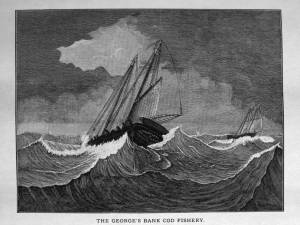
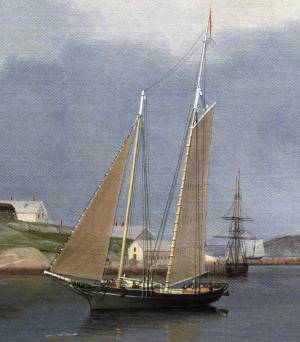
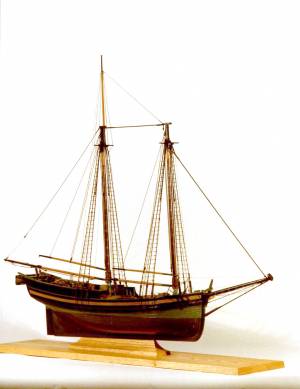


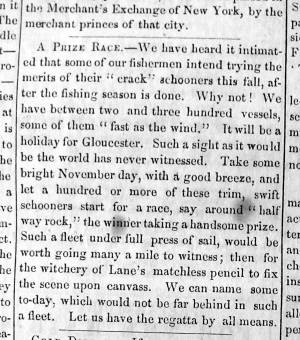
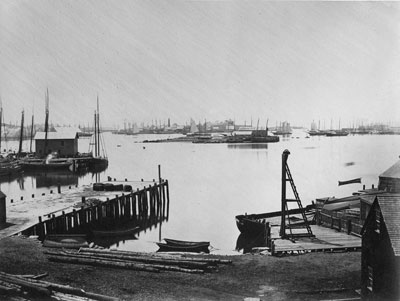

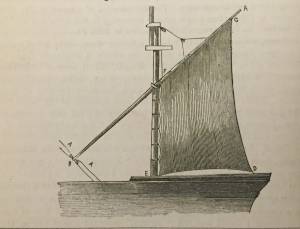
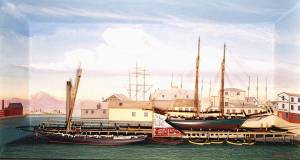

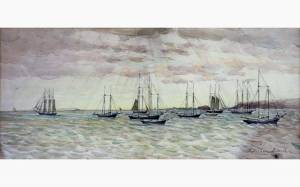


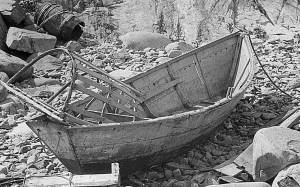


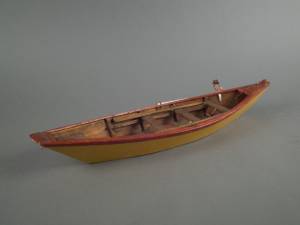
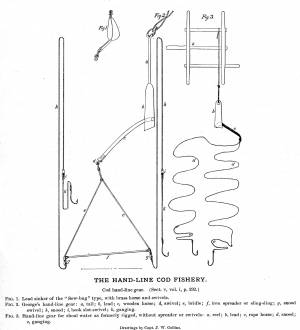
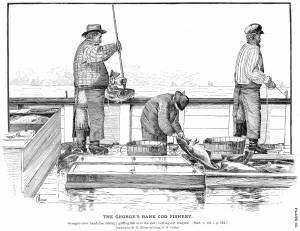
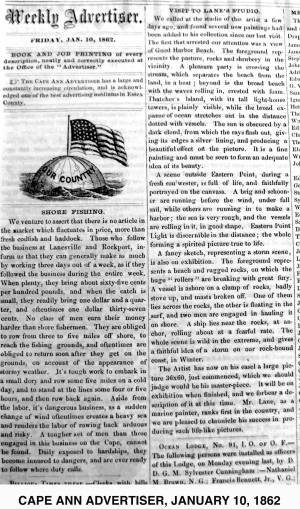
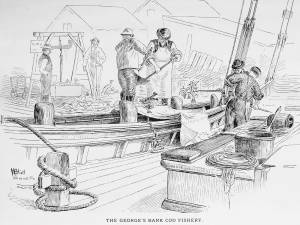

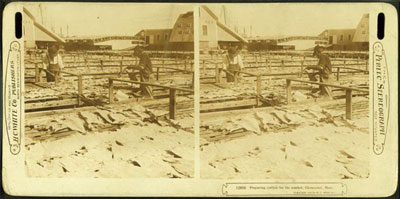








Commentary
This modest-sized painting, only 11 x 19 inches, is notable in that it is one of the rare paintings by Lane showing men fishing at sea as opposed to inshore. In this case, the men are hand-lining for cod or halibut off the side of the vessel. A scene such as this would have been common out on Georges Bank, an elevated area of the sea floor only sixty miles east of Gloucester.
Georges Bank was an abundant fishery that supported the Gloucester fleet for hundreds of years. As the inshore cod stocks were depleted near Cape Ann in the early 1800s, larger boats were built that could fish Georges Bank and return within several days. There was a growing demand for fresh fish in Boston, and the coming of the railroad to Gloucester in 1848 made it possible for the catch to get to the Boston market only a few hours after reaching the dock.
The Gloucester fishing fleet prospered and grew in numbers and vessel size, venturing ever farther afield in search of fish. However, fishing in the 1850s was still a crude and inefficient business. The men shown here are simply hand-lining off the rail and will pull in one or two fish at a time until the hold is full or until they need to run back to port. The great days of the Gloucester schooner fleet, when men in dories spooled out mile-long lines of hooks that could catch hundreds of fish at a time, were still twenty or so years in the future.
Both vessels in A Smart Blow carry a schooner rig, reefed down to handle the stiff breeze that is a near constant in the North Atlantic. Note the yawl boat hanging off the stern of the foreground vessel. For all the somewhat flat, two-dimensional quality of this painting, the yawl boat is beautifully volumetric, with an integrity of shape and a living, porpoise-like roundness that sets it off from the rest of the painting. This foreground schooner cresting the wave was later copied by Captain Addison Carter and used in his 1872 design of the Gloucester City seal (see below).
The other unusual element of this painting is the loose and energetic brushwork, particularly in the sky and wave-tops. Lane has laid on the paint more freely and with less blending than was his usual meticulous style. Seen up close, the oranges and pinks in the clouds and deep blues and blacks of the sky become a beautiful abstraction in themselves. Lane has painted the faces of the fishermen bright red, a wonderfully expressionist touch that belies his ultra-realist reputation.
The composition of A Smart Blow has a primitive charm to it. The angles of the heeling vessels' masts are perfectly matched, and the vessels sail in exactly opposite directions. The dark wave-shadow and spray in the lower right starts the eye on a counterclockwise motion to the far vessel, then moves left to the light in the sky, and back down to the larger vessel. The eye can just as easily travel in a clockwise motion. This opposing, circular symmetry adds to the primitive quality of the painting. It reminds us that Lane’s earliest exposure to paintings would have been to the work of early-American limners whose bold, patterned work (now called folk or naïve art) is seen as so distinctly American.
This is one of many paintings by Lane of which a copy exists by his pupil, Mary Mellen. The painting may be the one mentioned in the newspaper article below; if so, it would indicate that it was well-known.
– Sam Holdsworth
[+] See More